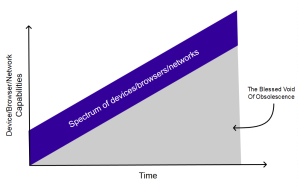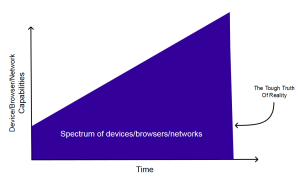I make no secret of the fact I’m a huge progressive enhancement believer. The fundamental reason why I believe the vast majority of web sites (yes, and web apps) should be written using progressive enhancement principles is that we just don’t know how they will be accessed.
We live in a time where many of us have powerful multi-core computers in our pockets, ridiculously fast Internet connections, high resolution screens, advanced web browsers supporting the latest web technologies. But even if we are one of those luck few, things go wrong.
Networks drop packets, servers go down, DNS fails. Resources on pages (most notably JavaScript) can fail to load or fail to run because of all manner of errors – both within and outside our control. Why would you not want to build your site in such a way that makes it as robust as possible?
This is how many developers believe the modern world looks:
The vertical axis is the capabilities of networks, devices and browsers. The horizontal access is time. As time goes on networks, devices and browsers get better, faster, more fully-featured. That’s true, these things do make progress.
But this belief gives developers a false sense of security, thinking they don’t need to worry about the same things they worried about in the past: crappy network connections, devices with hardly any RAM, browsers that don’t support modern JavaScript APIs etc. They put their trust in The Blessed Void Of Obsolescence.
But the harsh reality is more like this:
We should think about the massive possible spectrum of circumstances under which a user could interact with our sites.
Because even with a modern device things still go wrong. A user with the latest version of Google Chrome will get frustrated if your site doesn’t work because a CDN fails to deliver a crucial JavaScript file. All they will know is that your site doesn’t work.
Progressive enhancement is not about “what if users turn JavaScript off” but “what happens when the page is loaded in sub-optimal circumstances”.

